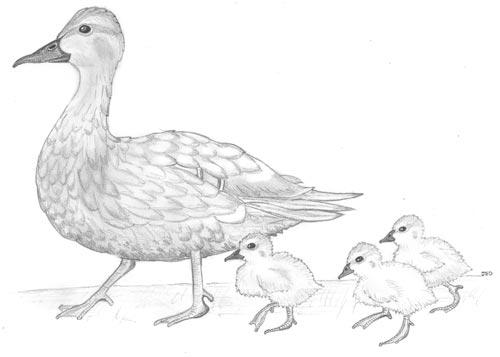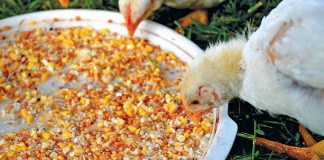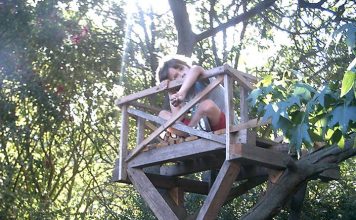| Issue #139 • January/February, 2013 |
Broodiness is an avian behavior that is frowned upon in the world of agriculture. All industrial agriculturalists cull broody birds because the behavior inhibits production. But to frugal homesteaders, broodiness just makes sense. When one of the girls goes broody, this is a time to gain the many benefits, whether it’s new hens for little cost or roosters for slaughter. Broody biddies come in many forms from the rather odd Muscovy duck to the small, tight-built game hen. Homestead broodies are practical, time-saving workhorses. They not only alleviate dealing with hatcheries, but they also eliminate the worry and work that comes with incubators and brooders.
Broody poultry
Turkeys and chickens are classified as “dry” poultry. They have similar nesting patterns and behaviors. Chickens are usually the only birds to become broody in the coop on nothing but their behinds. Turkeys and chickens are the only birds that can be moved from an existing nest; they are not as protective of their nests as waterfowl. In general, it takes 21-22 days to hatch chicken eggs and 28-29 days to hatch turkey eggs. Since chickens are more popular in the industrial world, the trait has been bred out of some breeds. Chickens most noted for broody behavior are Cochins, Silkies, and game-type chickens. However, the broodier types of chickens more suitable for homestead life tend to be Buff Orpingtons, Delawares, Australorps, and New Hampshire Reds. Heritage turkey varieties usually brood no matter what; exceptions would be the broad-breasted varieties bred for commercial production which cannot successfully mate on their own. Turkeys generally only lay eggs from mid-March to late June, depending on location and weather conditions.

Broody waterfowl
Ducks and geese are classified as waterfowl because of their love and need for water. Waterfowl always locate a nesting place, lay all of their eggs, and begin pulling their down feathers for insulation toward the end of the egg-laying period. These birds cannot be moved successfully once nesting has begun. My suggestion is that if you want them in a specific spot to incubate and brood, move them into their new home once the first egg has been laid, then lock them in there to do the job. It takes Mallard-derived breeds 28 days to hatch eggs, whereas the Muscovy takes up to 35 days to hatch eggs. I have attempted to incubate my duck eggs artificially, but allowing mama to take care of it has been more successful for me. Most Mallard-derived breeds lay year around like chickens and can set throughout the year. Muscovies, however, lay for a clutch (15 to 18 eggs) and will brood until completion. They can do this around three times a year. Muscovies are the best broody ducks, but the domestic Mallard, Ancona, and Welsh Harlequin can be good broodies as well.
It generally takes 30-33 days for mother goose to hatch her eggs. All goose breeds will generally become broody once every spring. Be careful, for they can get quite nasty if not left alone, especially the males.
Why let them set?
There are several reasons to let the girls brood eggs; one is that it is cheaper. The mother hen, duck, or goose alleviates the need to buy hatchlings or fertile eggs and incubating equipment from a hatchery. This saves you a lot of money. Broody birds save you time, too. You won’t have to fool with the incubator, which means you won’t have to worry about the egg turner tearing up in the middle of the incubation cycle or any other difficulty that can occur. Not to mention the care the chicks need in the brooder, which includes caring for pasty butt and hassling with the brooder lights.
Broodies are also a part of the homestead circle. They provide replacement females for your flock. Some people don’t let their birds set because it interferes with egg production. My broodies create the opposite problem, they increase production. Sure that hen is out of production for around 10 weeks, and on average you may lose around 45 to 50 eggs from that hen in this time frame. But she will start to lay eggs again. Not only will she lay, but her daughters will as well, close to six months after hatching. Say that the mother hen hatches five pullets, and if these girls lay around 4 to 5 eggs apiece each week, in the same time it took to grow out the chicks, they potentially could lay around 220 to 250 eggs, collectively. Also all the extra males can be converted into nutritious meat for table use; I consider these freebies. Mother hens, regardless of species, also teach their offspring to forage much earlier and waterfowl teach swimming earlier as well.
So, you have a broody?
The telltale signs of a broody chicken usually include squawking, irritability, and being very protective of her nest. These are the early signs. The hard-core broody chickens pull some feathers from their breast area so that they can be closer to the eggs. They assume the football pose to try and attack other birds around the feeder. My Muscovy ducks usually start peeping very quickly when I get near them, whether they are on the nest or even getting feed or water, as well as displaying the signs chickens normally show. The ducks will pull lots of fluffy down near the end of the laying cycle. Geese will also pull out down feathers, and the gander and the goose both get very protective of the nest and its area. It is recommended they be allowed to nest privately because they can get mean with children, pets, and other livestock.
Now that you have figured out you have a broody biddie, the first thing to do is make sure she is committed and then leave her be for a couple days, wherever she may start setting. Moving her too early can cause her to abandon the project altogether. Next, you need to determine where you should put her. It is a mess waiting to happen if she wants to set where there are two dozen other hens laying in her nest. The roosters can aggravate them, as well. The same thing will happen with the ducks; the drake will sometimes irritate the duck until she abandons the nest.
Moving a broody hen
Here’s how I move a broody chicken. After dusk has settled, I take a cat carrier or something of the sort to put her in, making sure the box has enough bedding (preferably hay). I also toss out the eggs under her (if she has any) because generally new eggs have been laid every day since she started and if they weren’t collected it can cause the hatches to be scrambled up. I take her to the new residence in the taxi, and give her 8 to 12 fertilized eggs that were collected that day. This is a good range to have too many and she can’t cover them. After I put in the eggs, I also make sure her cage is latched. Twenty-four hours after the eggs are put in, she probably has settled and has begun to incubate the eggs. I open the door of the cage and give her access to food and water. I also write down the first 24-hour period that has been completed as day one, and then figure it down to 21 days to get an estimate on the hatch date. I usually bring broodies to our spare coop, but there are other options, such as a broody box in the main coop, a rabbit hutch, or any place that protects her from predators and the elements.
I like to do just the opposite for my duck. You may think it’s crazy but it gave me a near perfect hatch. She went broody in the main coop, and since you can’t move waterfowl, I moved everyone else to the spare coop. On that hatch I got 16 ducklings from 17 eggs. I did leave her in there with the others once just to see how the hatch would go, and the eggs rotted in the shell and the coop started to smell. It wasn’t pleasant.
I keep my broody mamas on the same feed they’re used to until a few days before the hatch date, then I switch them to a non-medicated chick starter.

Hatching time
When it is hatch time, do not interfere. You will be tempted, but restrain yourself. It usually hinders the process rather than helping it. I must say it is quite an experience to peer in at the mama hen and see her with her new babies there is nothing like it! It’s important to clean the nest out, so when mama hen leaves the nest with her brood you can sneak in and retrieve the shell scraps and any eggs that did not hatch. I usually let mama and the chicks stay in privacy for about a week. Some people do not like the rest of the flock to mingle with the babies until they are around two months old or so, but I like to get them out young. This helps the older birds get used to them while the chicks still have mom to protect them.
Mother hens are very good about getting the chicks up the ramp and into the house every night. As each week goes by and you watch them grow, they begin to stray farther from mom. Then, after about eight or so weeks, she is done raising her brood and will return to laying eggs.
Common concerns
Here are some common worries poultry owners have. Usually during incubation you notice that mother hen, duck, or goose is not eating or drinking very much, if at all. This is normal some get up every day to eat and some wait almost a week. It differs from bird to bird and species to species. Weather also has a lot to do with it. If it’s hot they usually get up more often for the eggs to breathe.
Another worry is what to do when they go broody in the winter. This doesn’t bother me too much, however I am in Kentucky and winters are not as cold and bitter as Minnesota. When I had a hen go broody in the winter, I put her in the corner of my uninsulated coop with plenty of bedding beneath her and between her box and the floor. Plus I stacked a few bales of straw around her for added insulation. It worked wonderfully.
Another thing to know is that the mother bird will not defecate much; usually it comes out in large, smelly globs when she gets up to eat. This is very normal for broody birds.
Because of her limited feeding and the energy it takes to brood the eggs she will lose some size to her. This is normal, but you’ll need to watch her. I have heard of it killing a hen if her eggs do not hatch and she keeps setting for a few months. This has never happened to me.
Broody birds are homestead workhorses. They are cost effective by providing new females for the flock as well as excess males for table use. They make incubating easier on you, because they do the work and you reap the benefits. The brooding behavior can vary from breed to breed and species to species, but with a little knowledge you can make the broody bird a working part of your homestead.













